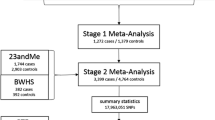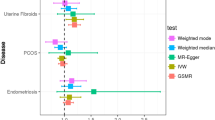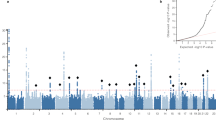Abstract
Uterine fibroids (UF) are common pelvic tumors in women, heritable, and genome-wide association studies (GWAS) have identified ~ 30 loci associated with increased risk in UF. Using summary statistics from a previously published UF GWAS performed in a non-Hispanic European Ancestry (NHW) female subset from the Electronic Medical Records and Genomics (eMERGE) Network, we constructed a polygenic risk score (PRS) for UF. UF-PRS was developed using PRSice and optimized in the separate clinical population of BioVU. PRS was validated using parallel methods of 10-fold cross-validation logistic regression and phenome-wide association study (PheWAS) in a seperate subset of eMERGE NHW females (validation set), excluding samples used in GWAS. PRSice determined pt < 0.001 and after linkage disequilibrium pruning (r2 < 0.2), 4458 variants were in the PRS which was significant (pseudo-R2 = 0.0018, p = 0.041). 10-fold cross-validation logistic regression modeling of validation set revealed the model had an area under the curve (AUC) value of 0.60 (95% confidence interval [CI] 0.58–0.62) when plotted in a receiver operator curve (ROC). PheWAS identified six phecodes associated with the PRS with the most significant phenotypes being 218 ‘benign neoplasm of uterus’ and 218.1 ‘uterine leiomyoma’ (p = 1.94 × 10–23, OR 1.31 [95% CI 1.26–1.37] and p = 3.50 × 10–23, OR 1.32 [95% CI 1.26–1.37]). We have developed and validated the first PRS for UF. We find our PRS has predictive ability for UF and captures genetic architecture of increased risk for UF that can be used in further studies.




Similar content being viewed by others
Data availability
The authors declare that the data supporting the findings of this study are available within the article and its supplemental tables. Variants and their respective weights and alleles contained in the PRS are available in Supplemental Table 1. Data used to construct the PRS will be made available in PGS catalog upon publication. Full summary statistics from the UF GWAS used to construct the PRS are available in MRBase.
References
Adeyemo A, Balaconis MK, Darnes DR, Fatumo S, Granados Moreno P et al (2021) Responsible use of polygenic risk scores in the clinic: potential benefits, risks and gaps. Nat Med 27:1876–1884
Andersen J (1996) Growth factors and cytokines in uterine leiomyomas. Semin Reprod Endocrinol 14:269–282
Baird DD, Dunson DB, Hill MC, Cousins D, Schectman JM (2003) High cumulative incidence of uterine leiomyoma in black and white women: ultrasound evidence. Am J Obstet Gynecol 188:100–107
Cardozo ER, Clark AD, Banks NK, Henne MB, Stegmann BJ et al (2012) The estimated annual cost of uterine leiomyomata in the United States. Am J Obstet Gynecol 206:211.e211-219
Cha PC, Takahashi A, Hosono N, Low S-K, Kamatani N, Kubo M, Nakamura Y (2011) A genome-wide association study identifies three loci associated with susceptibility to uterine fibroids. Nat Genet 43(5):447–450
Chatterjee N, Shi J, Garcia-Closas M (2016) Developing and evaluatung polygenic risk prediction models for stratified disease prevention. Nat Rev Genet 17:392–406
Choi SW, Mak TS-H, O’Reilly PF (2020) Tutorial: a guide to performing polygenic risk score analyses. Nat Protoc 15:2759–2772
Coronado GD, Marshall LM, Schwartz SM (2000) Complications in pregnancy, labor, and delivery wither uterine leiomyomas: a population-based study. Obstet Gynecol 95:764–769
Das S, Forer L, Schonherr S, Sidore C, Locke AE, Kwong A, Vrieze SI, Chew EY, Levy S, McGue M, Schlessinger D, Stambolian D, Loh PR, Iacono WG, Swaroop A, Scott LJ, Cucca F, Kronenberg F, Boehnke M, Abecasis GR, Fuchsberger C (2016) Next-generation genotype imputation service and methods. Nat Genet 48(10):1284–1287
Denny JC, Ritchie MD, Basford MA, Pulley JM, Bastarache L et al (2010) PheWAS: demonstrating the feasibility of a phenome-wide scan to discover gene-disease associations. Bioinformatics 26:1205–1210
Denny JC, Bastarache L, Ritchie MD, Carroll RJ, Zink R et al (2013) Systematic comparison of phenome-wide association study of electronic medical record data and genome-wide association study data. Nat Biotechnol 31:1102–1111
Dikilitas O, Schaid DJ, Kosel ML, Carroll RJ, Chute CG et al (2020) Predictive utility of polygenic risk scores for coronary heart disease in three major racial and ethnic groups. Am J Hum Genet 106:707–716
Edwards TL, Hartmann KE, Velez Edwards DR (2013) Variants in BET1L and TNRC6B associate with increasing fibroid volume and fibroid type among European Americans. Hum Genet 132:1361–1369
Edwards TL, Giri A, Hellwege JN, Hartmann KE, Stewart EA et al (2019) A trans-ethnic genome-wide association study of uterine fibroids. Front Genet 10:511
Eggert SL, Huyck KL, Somasundaram P, Kavalla R, Stewart EA et al (2012) Genome-wide linkage and association analyses implicate FASN in predisposition to uterine leiomyomata. Am J Hum Genet 91:621–628
Euesden J, Lewis CM, O’Reilly PF (2015) PRSice: Polygenic Risk Score software. Bioinformatics 31:1466–1468
Feingold-Link L, Edwards TL, Jones S, Hartmann KE, Velez Edwards DR (2014) Enhancing uterine fibroid research through utilization of biorepositories linked to electronic medical record data. J Womens Health (larchmt) 23:1027–1032
Gallagher CS, Makinen N, Harris HR, Rahmioglu N, Uimari O et al (2019) Genome-wide association and epidemiological analyses reveal common genetic origins between uterine leiomyomata and endometriosis. Nat Commun 10:4857
Marchini J, Howie B, Myers S, McVean G, Donnelly P (2007) A new multipoint method for genome-wide association studies by imputation of genotypes. Nat Genet 39:906–913
Markowski DN, Bartnitzke S, Loning T, Drieschner N, Helmke BM, Bullerdiek J (2012) MED12 mutations in uterine fibroids—their relationship to cytogenetic subgroups. Int J Cancer 131(7):1528–1536 (Electronic)
Martin AR, Kanai M, Kamatani Y, Okada Y, Neale BM et al (2019) Clinical use of current polygenic risk scores may exacerbate health disparities. Nat Genet 51:584–591
McCarty CA, Chisholm RL, Chute CG, Kullo IJ, Jarvik GP et al (2011) The eMERGE Network: a consortium of biorepositories linked to electronic medical records data for conducting genomic studies. BMC Med Genom 4:13
Parazzini FMD, Tozzi LMD, Bianchi SMD (2015) Pregnancy outcome and uterine fibroids. Best practice & research. Clin Obstet Gynaecol 34:74–84
Qidwai GI, Caughey AB, Jacoby AF (2006) Obstetric outcomes in women with sonographically identified uterine leiomyomata. Obstet Gynecol 107:376–382
Radosa MP, Owsianowski Z, Mothes A, Weisheit A, Vorwergk J et al (2014) Long-term risk of fibroid recurrence after laparoscopic myomectomy. Eur J Obstet Gynecol Reprod Biol 180:35–39
Rafnar T, Gunnarsson B, Stefansson OA, Sulem P, Ingason A et al (2018) Variants associating with uterine leiomyoma highlight genetic background shared by various cancers and hormone-related traits. Nat Commun 9(1):3636
Robin X, Turck N, Hainard A, Tiberti N, Lisacek F, Sanchez J-C, Müller M (2011) pROC: an open-source package for R and S+ to analyze and compare ROC curves. BMC Bioinform
Roden DM, Pulley JM, Basford MA, Bernard GR, Clayton EW et al (2008) Development of a large-scale de-identified DNA biobank to enable personalized medicine. Clin Pharmacol Ther 84:362–369
Stanaway IB, Hall TO, Rosenthal EA, Palmer M, Naranbhai V et al (2019) The eMERGE genotype set of 83,717 subjects imputed to ~40 million variants genome wide and association with the herpes zoster medical record phenotype. Genet Epidemiol 43:63–81
Styer AK, Rueda BR (2016) The epidemiology and genetics of uterine leiomyoma. Best practice & research. Clin Obstet Gynaecol 34:3–12
Templeman C, Marshall SF, Clarke CA, Henderson KD, Largent J et al (2009) Risk factors for surgically removed fibroids in a large cohort of teachers. Fertil Steril 92:1436–1446
Terry KL, De Vivo I, Hankinson SE, Missmer SA (2010) Reproductive characteristics and risk of uterine leiomyomata. Fertil Steril 94(7):2703-2707 (Electronic)
Välimäki N, Kuisma H, Pasanen A, Heikinheimo O, Sjöberg J et al (2018) Genetic predisposition to uterine leiomyoma is determined by loci for genitourinary development and genome stability. Elife 7:e37110
Whickam H (2016) ggplot2: Elegant graphics for data analysis. Springer-Verlag, New York
Wise LA, Laughlin-Tommaso SK (2016) Epidemiology of uterine fibroids: from menarche to menopause. Clin Obstet Gynecol 59(1):2–24
Funding
This research was funded by the National Institutes of Health through the following grants: [R01HD074711, R03HD078567, R01HD093671 to D.R.V.E., T32GM080178 to J.A.P., U01HG006378 to D. R., K12HD04348 to J.N.H.]. This research has been conducted using the UK Biobank Resource (Project ID: 13869). The Mayo Clinic is funded by HG06379. This phase of the eMERGE Network was initiated and funded by the National Human Genome Research Institute through the following grants: U01HG8657 (Group Health Cooperative/University of Washington); U01HG8685 (Brigham and Women’s Hospital); U01HG8672 (Vanderbilt University Medical Center); U01HG8666 (Cincinnati Children’s Hospital Medical Center); U01HG6379 (Mayo Clinic); U01HG8679 (Geisinger Clinic); U01HG8680 (Columbia University Health Sciences); U01HG8684 (Children’s Hospital of Philadelphia); U01HG8673 (Northwestern University); U01HG8701 (Vanderbilt University Medical Center serving as the Coordinating Center); U01HG8676 (Partners Healthcare/Broad Institute); and U01HG8664 (Baylor College of Medicine).
Author information
Authors and Affiliations
Contributions
YZ, GPJ, OD, IJK, DJS, DRC, SAP, MTML, and DRVE designed the study. YZ, GPJ, OD, IJK, DJS, DRC, SAP, MTML, JCD, and DR contributed to phenotypical/clinical aspects of cohorts. YZ, GPJ, OD, IJK, DJS, DRC, SAP, MTML, and EST contributed to genotyping, quality control, imputation, and/or analysis of genotyping data. JNH constructed the UL PRS and calculated a PRS for all participants in eMERGE and BioVU. JAP performed PheWAS and Mendelian randomization. JAP and DRVE drafted the paper. JNH, YZ, OD, IJK, EST, GPJ, DJS, DRC, SAP, MTML, DR, JCD, and TLE provided critical comments on paper, draft, and analysis. All authors read and approved the final paper.
Corresponding author
Ethics declarations
Conflict of interest
All authors have no relevant financial or non-financial interests to disclose.
Ethics approval
The Institutional Review Board (IRB) of Vanderbilt University approved this study and confirmed no ethical approval is required.
Additional information
Publisher's Note
Springer Nature remains neutral with regard to jurisdictional claims in published maps and institutional affiliations.
Supplementary Information
Below is the link to the electronic supplementary material.
Rights and permissions
About this article
Cite this article
Piekos, J.A., Hellwege, J.N., Zhang, Y. et al. Uterine fibroid polygenic risk score (PRS) associates and predicts risk for uterine fibroid. Hum Genet 141, 1739–1748 (2022). https://doi.org/10.1007/s00439-022-02442-z
Received:
Accepted:
Published:
Issue Date:
DOI: https://doi.org/10.1007/s00439-022-02442-z




